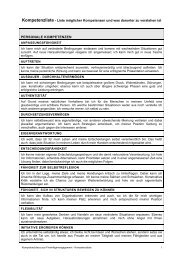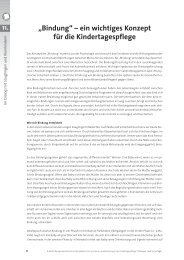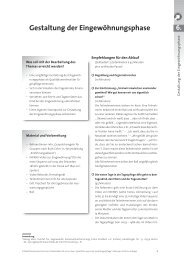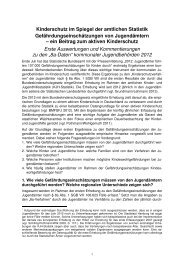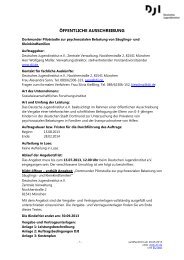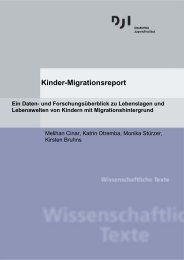download - Deutsches Jugendinstitut e.V.
download - Deutsches Jugendinstitut e.V.
download - Deutsches Jugendinstitut e.V.
Create successful ePaper yourself
Turn your PDF publications into a flip-book with our unique Google optimized e-Paper software.
• individual encouragement of talents among cliques and target groups;<br />
• individual mentoring in youth and family social work and work within<br />
education fields.<br />
Type poverty neighbourhoods adjacent to consumer-oriented areas:<br />
• In contrast to the ghetto type, urban “niches“ and retreat areas should be<br />
created in these areas – through structural and spatial separation – which<br />
together with targeted local strategies provide an alternative to the “consumeroriented<br />
forays” on the part of child and youth residents.<br />
• With the aid of sponsoring activities and “adoption schemes“, young persons<br />
should become involved in local businesses in work-oriented form (jobs,<br />
practical experience and apprenticeship training schemes).<br />
• Greater significance should be given to secondary prevention in schools and<br />
day-care centres and within child and youth welfare work.<br />
• Separate activities for children and youths resident in city areas should<br />
guarantee that these groups do not become oriented towards problematic<br />
children and youths who are non-residents but co-utilise these urban areas. This<br />
is only possible if separate social-educationally accompanied aid, leisure and<br />
cultural activities exist for both groups.<br />
Type “insecure” urban areas threatened by decline:<br />
• In these areas, the traditional socio-cultural self-organisational forms within<br />
neighbourhoods, associations and economic connections are mostly still<br />
present. These forms must be stabilised, modernised and slowly opened to new<br />
(immigrant) inhabitants. If necessary, the self-help potential should be<br />
reactivated through external stimulation.<br />
• The previously existing socio-cultural infrastructure should be adjusted to the<br />
new currently existing structure of inhabitants with the aid of district<br />
management.<br />
• A targeted prevention of violence on a secondary and tertiary prevention level<br />
appears to be suitable for schools and youth welfare institutions.<br />
Type disintegrating areas:<br />
• Separational and centrifugal forces frequently dominate in this area type. There<br />
is often a lack of awareness for historical identity and traditional integration<br />
processes and rituals, necessitating the construction of a new socio-cultural<br />
infrastructure. New regulation systems and a stepwise integration concept (cf.<br />
Gaitanides, Hamburger) appear to be necessary in this case.<br />
• Intercultural mediation and both confrontational and accepting methods also<br />
appear to be appropriate. Local social education approaches must particularly<br />
target breaches of regulations in order to permit the medium-term creation of<br />
regulation systems among the resident groups<br />
• Overall, socio-environmentally differentiated integration work should begin<br />
with existing potentials and resources and not primarily with existing deficits. It<br />
should be a matter of course to integrate affected persons in the planning and<br />
conceptualisation of these work approaches.<br />
96





